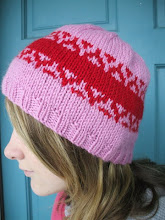
I'm obsessed! One small piece of knitted lace and I'm completely and utterly hooked. Honestly, I must be easily led. Last night, while everyone else was watching tv, babysitting or hanging out in their workshop, I was surfing Ravelry and drooling over lace. I think I just doubled my favourites in one go!
Then ofcourse that leads on to drooling over lace yarn. I've looked at everything from fine cobweb to handspun with beads. It's a whole subcategory of yarnology. ("yarnology", is that a word? Well, it is now.)
If you're a knitter, you've got to know your yarnology. It's an extensive field and with the advent of the internet, an ever increasing one too. Yarn knowledge seems to be hugely complicated and the more I read about different yarns, the more I just can't wait to try them out. Honestly, a little bit of knowledge takes yarn petting to a whole new dimension.
I've discovered that the Alaskan yarn Quiviut (Pronounced: KIV-EE-UT) is the most coveted fiber out there. It comes from wild musk ox which reside up in the arctic circle. Musk ox are relics of the ice age some 20,000 years ago. They lived at a time when saber-toothed tigers and woolly mammoths roamed the treeless high Arctic. As you can imagine, they have very thick fur that keeps them warm during the arctic winter. Their outside hair is called guard hair, the very long hair on the back, but leading up to winter they start growing underwool which is called quiviut. It is very light and soft and is perhaps one of the finest fibers there is. Consequently, the price of quiviut is more than $40 per ounce, yet demand by us knitters far outstrips supply.
This will be one fiber to watch as the world faces the challenges of climate change though. As the arctic gets warmer and the ice melts, what will happen to the musk ox? Will it die out or will it adapt to the new climate and if so, will this mean no more quiviut?
Something to think about, isn't it.











No comments:
Post a Comment